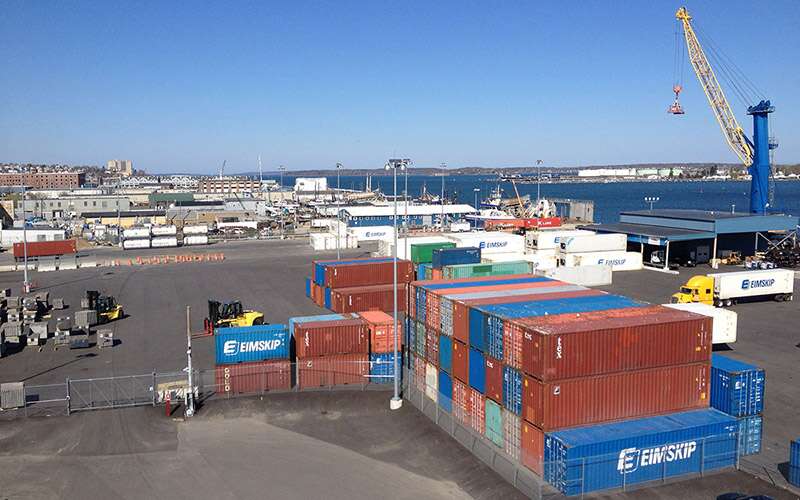
MDOT unveils three-year $2.3 billion work plan
 Courtesy / Maine Department of Transportation
The Maine Department of Transportation's annual three-year work plan, which includes 2,262 projects totalling $2.3 billion, also has an added emphasis on highway safety this year — with a particular focus on Interstate 295, shown above in this file photo, where crash incidence is high.
Courtesy / Maine Department of Transportation
The Maine Department of Transportation's annual three-year work plan, which includes 2,262 projects totalling $2.3 billion, also has an added emphasis on highway safety this year — with a particular focus on Interstate 295, shown above in this file photo, where crash incidence is high.
The Maine Department of Transportation’s annual three-year work plan, which includes 2,262 projects totaling $2.3 billion, also has an added emphasis on highway safety this year.
The plan, released last week, includes 1,136 projects slated for 2018, according to the plan.
In this year’s plan, safety “is an emphasis area that merits special attention,” said DOT Commissioner David Bernhardt in his introduction.
Bernhardt said while safety has always been the top priority of the department, recent trends have put more emphasis on it.
“But after a decade of improvement, safety performance on the transportation system across America has been trending in the wrong direction, with vehicle crashes, injuries and fatalities increasing in parallel with the growth in vehicle miles traveled,” Bernhardt said. “In Maine, highway deaths have been inching their way back up to previous levels.”
There were 30,482 motor vehicle crashes on the state’s highways involving 48,158 vehicles, according to state records. The statistics for 2017 aren’t yet available.
Bernhardt said motorcycle crashes and pedestrian fatalities, which have doubled in four years, are of particular concern.

The plan on the whole adjusts projects planned for 2019 from last year’s plan, revising costs estimates, schedules and project scope to reflect changing conditions and adds projects for the third year, 2020.
The three-year work plan includes more than $1.4 billion in highway, bridge and multimodal capital work — major improvement projects with defined beginning and end dates. Projects include bridge replacements, highway construction and paving, acquisition of buses and ferries, sidewalk construction, and major improvements to airports, the report says.
Some $1.1 billion of the cost is highway and bridge projects and more than $296 million is in multimodal (marine, freight, transit, aviation, ferry) projects.
2018 snapshot
This year, there are 1,136 work items planned by the MDOT. They include:
- 604 capital projects at an estimated cost of $511.1 million.
- 48 miles of highway construction and rehabilitation at an estimated cost of $67.6 million.
- 356 miles of preservation paving and an estimated cost of $93.8 million.
- 600 Miles of light capital paving at an estimated cost of $22 million.
- 48 highway spot and safety improvements at an estimated cost of $28.6 million.
- 106 highway bridge projects at an estimated cost of $118.8 million.
- $149.5 million in maintenance and operations activities, including 336 maintenance projects and an estimated cost of $26.1 million.
- 28 transportation planning and research activities, at an estimated cost of $4.55 million.
- $10.96 million for administration.
- 44 capital aviation projects at an estimated cost of $43.95 million.
- 9 port and marine projects and activities, at an estimated cost of $18.7 million.
- 7 freight rail projects and activities at an estimated cost of $15.9 million.
- 38 public transit (bus, commuter, ferry) projects at an estimated cost of $63 million.
- A project to replace a Casco Bay Island Transit District ferry an an estimated cost of $10 milion.
- 23 bicycle and pedestrian capital projects at an estimated cost of $7.84 million.
Three-year interstate highway projects
The report says that the largest and most heavily traveled component of Maine’s transportation system is its 8,800-mile state highway network.
“Maine’s need to invest in the preservation of the existing highway and bridge system is significan,” the plan says.
The more than $1.1 billion designated to highway and bridge capital projects over the three years of the plan include:
- 229 miles of highway construction and rehabilitation at an estimated cost of $205 million.
- 1,128 miles of preservation paving at an estimated cost of $286 million.
- 1,800 miles of light capital paving at an estimated cost of $71 million.
- 240 safety and spot improvements at an estimated cost of $111 million.
- 260 bridge projects at an estimated cost of $353 million.
Three-year intermodal projects
The plan includes more than $28 million in state funding for marine-freight projects and other improvements to public marine facilities, including:
- $4.5 million for a mobile harbor crane at the International Marine Terminal in Portland.
- $3.6 million for waterfront infrastructure at Mack Point in Searsport.
- $5.5 million for dredging the commercial shipping channel at the port of Searsport.
- $38 million in freight rail capital funding, including operational improvements on state-owned rail lines, improvements at railroad crossings, improvements to critical rail bridges and other rail line capital projects.
- $3.75 million in state money for the Industrial Rail Access Program, which will leverage another $3.75 million in private funding.
Transit programs statewide are slated $39.4 million, including $31.7 million in federal capital funding, $7 million in local funding and approximately $600,000 in state funding to support 20 regional and local transit providers.
Aviation, ferry, bicycle and pedestrian projects are also in the plan, supported by federal, state and local funding.









Comments